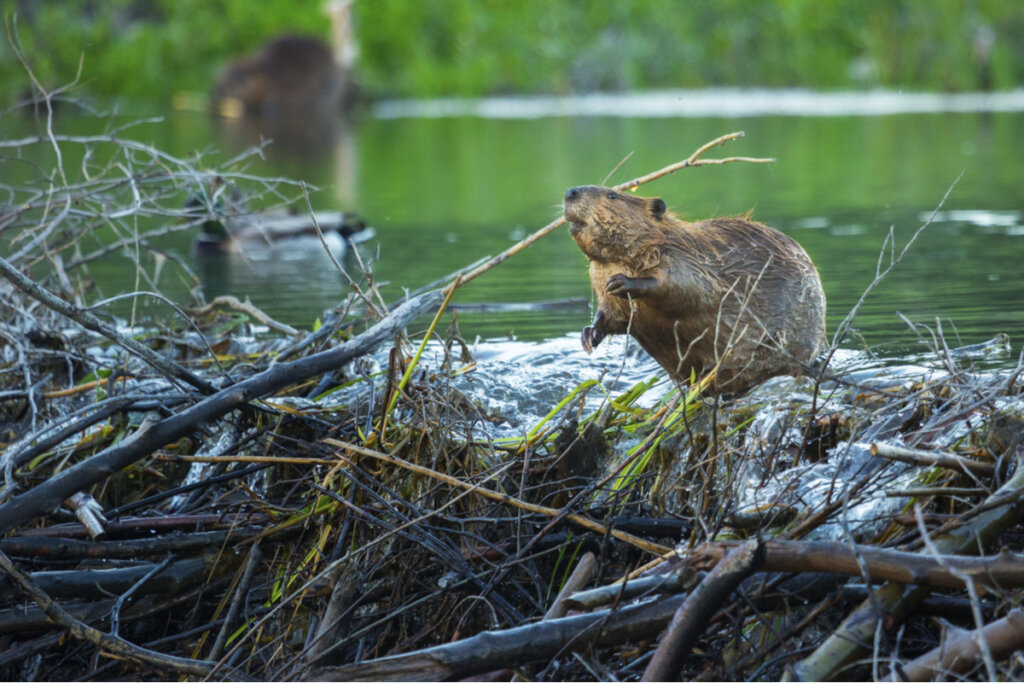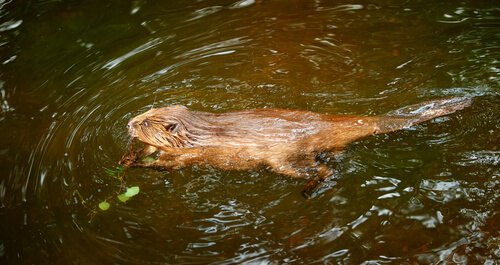Relocated Beavers Helped Mitigate Climate Change Damage

Several places around the world have already experienced the effects of climate change. Floods, droughts, intense heat waves, and warmer water temperatures are just a few of the most well-known examples today.
Among all this bad news, a recent study has found that some newly relocated beavers have helped mitigate the effects of climate change. Let’s find out more!
Beavers are categorized as ecosystem engineers, as they’re able to modify habitats and cause different physicochemical changes in their environment. For this reason, it isn’t surprising that beavers are able to mitigate the effects of climate change. Read on to find out how they manage to do it.
Beavers and the environment
The beaver (Castor canadensis) is a rodent, native to North America, which is capable of cutting down mature trees for food and building its home. In fact, it’s also responsible for creating a type of natural dam. It’s this behavior that has earned it the title of ecosystem engineer.
Although they may seem unimportant, dams cause the water level of the rivers to rise progressively. Likewise, the land becomes wetter and more water infiltrates into the soil layers, which prevents soil erosion and even holds back certain pollutants.
Thanks to all the changes produced by beavers with their constructions, different plant and animal species benefit from their presence. On the one hand, various fish, insects and amphibians take advantage of the increased water level, while vegetation uses the extra moisture to grow and spread.

They do not always help the ecosystem
Although it’s true that beavers create a large number of ecosystem benefits, this only occurs if they’re in their natural habitats. If they’re introduced into areas new to the species, the effect on the environment can be negative and could even cause a dangerous ecological imbalance.
An example of this is the effect beavers have had when introduced into the Tierra del Fuego archipelago. On these islands, they have destroyed riparian forests, changed the structure and population of aquatic species, and even modified the temperature and nutrients of the river.
The reintroduction of beavers to the Skykomish River
Most of the beavers distributed throughout the United States were wiped out in the 20th century, as their fur was used as raw material for clothing. Due to this, many ecosystems in this nation were affected and began to have different ecological problems.
As if this weren’t enough, climate change began to wreak havoc in different rivers and ended up transforming the entire hydrology of the ecosystems. In the case of the Skykomish River, water temperature increased, snowstorms turned into heavy rains and snowfall covers became smaller and smaller.
Thanks to the current awareness of the importance and the impact beavers have on the environment, since 2014 several reintroduction programs have begun to influence things.
One of these projects was carried out in the Skykomish River, where 69 specimens were relocated in 13 strategic points to try to correct the ravages of the ecosystem.

The benefits of reintroducing beavers
In 2022, a study published in the journal Ecosphere analyzed the effects of reintroduction programs on the Skykomish River. First, the creation of the dams caused the water level to rise and lowered its temperature by more than 2 degrees Celsius. It also increased humidity and improved water availability for plant species.
The ecosystem changes also benefited other iconic animals such as salmon, which were beginning to suffer from the warming water. This means that the simple reintroduction of beavers helped mitigate some of the effects of climate change and ecological imbalance.
Another important point to note is that these changes occurred one year after their reintroduction. Consequently, the current benefits are only the beginning of the story, as it’ll still be some time before the beavers are fully established.
As you can see, this is another wonderful example of what a single species is capable of doing in an ecosystem. Reintroduction has been, and will be, a key weapon in the restoration of the environment.
Of course, there’s still some way to go to establish these strategies, but the focus of these projects is very promising.
All cited sources were thoroughly reviewed by our team to ensure their quality, reliability, currency, and validity. The bibliography of this article was considered reliable and of academic or scientific accuracy.
- Dittbrenner, B. J., Schilling, J. W., Torgersen, C. E., & Lawler, J. J. (2022). Relocated beaver can increase water storage and decrease stream temperature in headwater streams. Ecosphere, 13(7), e4168.
- Dittbrenner, B. J. (2019). Restoration potential of beaver for hydrological resilience in a changing climate (Doctoral dissertation).
- Baldini, A., Oltremari, J., & Ramírez, M. (2008). Impacto del castor (Castor canadensis, Rodentia) en bosques de lenga (Nothofagus pumilio) de Tierra del Fuego, Chile. Bosque (Valdivia), 29(2), 162-169.
- Bailey, D. R., Dittbrenner, B. J., & Yocom, K. P. (2019). Reintegrating the North American beaver (Castor canadensis) in the urban landscape. Wiley Interdisciplinary Reviews: Water, 6(1), e1323.
- Mariana, Fasanella & Lizarralde, Marta. (2012). The invasive beaver Castor Canadensis in the tierra del fuego archipelago: A mitochondrial DNA and spatial genetic structure analysis for controlling population expansion. Invasive Species: Threats, Ecological Impact and Control Methods. 101-122.
